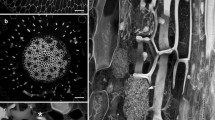Summary
Initial study indicated that much callose is produced in pea root tissues during the preparation of fresh hand-cut sections or during conventional fixation in formalin-acetic acid-alcohol, glutaraldehyde or acrolein. In contrast, there is little callose in freeze-substituted tissues and this is mostly in sieve tubes and considered endogenous. Freeze-substitution was subsequently used to monitor wound-induced callose development in the various tissues of pea roots. This development was fastest in the phloem, first detected 1 minute post-wounding and complete by 3 hours. In some parenchyma cells full development was delayed by 20 hours. By 100 hours, wound callose was no longer detectable in parenchyma cells but remained undiminished in the phloem. The implications of these results for all studies involving callose localization are discussed.
Similar content being viewed by others
Abbreviations
- C:
-
callose
- FAA:
-
formalin-acetic acid-alcohol
- GMA:
-
glycol methacrylate
- P:
-
phloem
- PAS:
-
periodic acid-Schiffs
- PF:
-
phloem fibres
- PP:
-
pith parenchyma
- PW:
-
post-wounding
References
Aist JR (1976) Papillae and related wound plugs of plant cells. Ann Rev Phytopath 14: 145–163
Clarke KJ, McCully ME (1985) The occurrence of wall papulae in root epidermis cells of axenically grown seedlings ofZea mays. Am J Bot 72: 1483–1489
Cooper KM (1982) Callose-deposit formation in radish root hairs. In:Brown RM Jr (ed) Cellulose and other natural polymer systems. Plenum Press, New York, pp 167–184
Crafts AS, Currier HB (1963) On sieve tube function. Protoplasma 57: 188–202
Currier HB (1957) Callose substance in plant cells. Am J Bot 44: 478–488
—,Shih CY (1968) Sieve tubes and callose inElodea leaves. Am J Bot 55: 145–152
—,Strugger S (1956) Aniline blue and fluorescence microscopy of callose in bulb scales ofAllium cepa L. Protoplasma 45: 552–559
—,Webster DH (1964) Callose formation and subsequent disappearance: Studies in ultrasound stimulation. Pl Phys 39: 843–847
Drake GA, Carr DJ, Anderson WP (1978) Plasmolysis, plasmodesmata and the electrical coupling of oat coleoptile cells. J Exp Bot 29: 1205–1214
Engleman EM (1965) Sieve element ofImpatiens sultanii. 1. Wound reaction. Ann Bot NS 29: 83–101
Esau K, Thorsch J (1985) Sieve plate pores and plasmodesmata, the communication channels of the symplast: ultrastructural aspects and developmental relations. Am J Bot 72: 1641–1653
Eschrich W (1961) Untersuchungen über den Ab- und Aufbau der Callose. Z Bot 49: 153–218
— (1963) Beziehungen zwischen dem Auftreten von Callose und der Feinstruktur des primären Phloems beiCucurbita ficifilia. Planta 59: 243–261
— (1975) Sealing systems in phloem. In:Zimmermann MH, Milburn JA (eds) Encyclopedia of plant physiology, N.S., vol 1. Springer, Berlin Heidelberg New York, pp 39–56
—,Hüttermann A, Heyser W, Tammes PML, Die J van (1972) Evidence for the synthesis of “callose” in sieve-tube exudate ofYucca flaccida. Z Pflanzenphysiol 67: 468–470
Evert RF, Derr WF (1964) Callose substance in sieve elements. Am J Bot 51: 552–559
Fincher GB, Stone BA (1981) Metabolism of non-cellulosic poly saccharides. In:Tanner W, Loewus FA (eds) Plant carbohydrates II. Encyclopedia of plant physiology, N.S., vol 13 B. Springer, Berlin Heidelberg New York, pp 68–136
Fischer A (1886) Neue Beiträge zur Kenntnis der Siebröhren. Ber Kgl sächs Ges Wiss math-phys Kl 38: 291–336
Fulcher RG, McCully ME, Setterfield G, Sutherland J (1976) β-1,3-glucans may be associated with cell plate formation during cytokinesis. Can J Bot 54: 539–542
Gilkey JC, Staehelin LA (1986) Advances in ultrarapid freezing for the preservation of cellular ultrastructure. J Elect Microsc Tech 3: 177–210
Guinel FC, McCully ME (1985) Evaluation of the specificity of lectin binding to sections of plant tissue. Histochem 83: 265–277
Heininger U (1981) β-1,3-glucan synthesis in potato tubers. In:Robinson DG, Quader H (eds) Cell walls '81: Proceedings of the second cell wall meeting held in Göttingen April 8th–11th 1981. Wissenschaftliche Verlagsgesellschaft, Stuttgart
Hughes JE, Gunning BES (1980) Glutaraldehyde-induced deposition of callose. Can J Bot 58: 250–258
Jaffe MJ, Huberman M, Johnson J, Telewski FW (1985) Thigmomorphogenesis: The induction of callose formation and ethylene evolution by mechanical perturbation in bean stems. Physiol Plant 64: 271–279
—,Leopold AC (1984) Callose deposition during gravitropism ofZea mays andPisum sativum and its inhibition by 2-deoxy-D-glucose. Planta 161: 20–26
Kauss H (1985) Callose biosynthesis as a Ca2+-regulated process and possible relations to the induction of other metabolic changes. J Cell Sci [Suppl] 2: 89–103
Knox RB (1984) Pollen-pistil interactions. In:Linskens HF, Heslop-Harrison J (eds) Encyclopedia of plant physiology, N.S., vol 17: Cellular-interactions, pp 508–608. Springer, Berlin Heidelberg New York
Longly B, Waterkeyn L (1977) Ètude de la cytocinèse. 1. Les stades callosiques de la plaque cellulaire somatique. La Cellule 70: 195–224
Mersey B, McCully ME (1978) Monitoring of the course of fixation of plant cells. J Micros 114: 49–76
O'Brien TP, McCully ME (1981) The study of plant structure: principles and selected methods. Termarcarphi Pty, Melbourne
Schulz A (1986) Wound phloem in transition to bundle phloem in primary roots ofPisum sativum L. II. The plasmatic contact between wound-sieve tubes and regular phloem. Protoplasma 130: 27–40
Smith MM, McCully ME (1977) Mild temperature “stress” and callose synthesis. Planta 136: 65–70
— — (1978 a) Enhancing aniline blue fluorescent staining of cell wall structures. Stain Tech 53: 79–85
— — (1978 b) A critical evaluation of the specificity of aniline blue induced fluorescence. Protoplasma 95: 229–254
Tighe DM, Heath MC (1982) Callose induction in cowpea by uridine diphosphate glucose and calcium phosphate-boric acid treatments. Pl Physiol 69: 366–370
Author information
Authors and Affiliations
Rights and permissions
About this article
Cite this article
Galway, M.E., McCully, M.E. The time course of the induction of callose in wounded pea roots. Protoplasma 139, 77–91 (1987). https://doi.org/10.1007/BF01282278
Received:
Accepted:
Issue Date:
DOI: https://doi.org/10.1007/BF01282278




